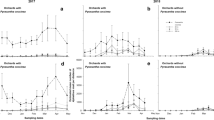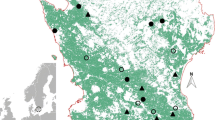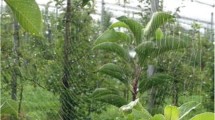Abstract
The influence of three margin strip treatments (wildflower strips, grass strips and spontaneous vegetation) adjacent to apple orchards on the biological control of Dysaphis plantaginea Passerini (Hemiptera: Aphididae) was compared during two consecutive years. The wildflower strips provided the highest amount of floral resources. Within the margin strips, hoverflies responded positively to higher resource provisioning whereas ladybird abundance did not differ between strip treatments. Within the orchards, the presence of parasitoids, hoverflies, and ladybirds in aphid colonies and the predation of sentinel aphids were not significantly affected by the adjacent strip treatments. The number of natural enemies observed in aphid colonies was mainly driven by aphid number. Aphid numbers were higher close to the margin strips suggesting that aphid colonization from orchard edges may counteract the positive effect of wildflower strips on natural enemy abundance and on a reduction of aphid infestation. The results confirm the positive influence of floral resource provisioning by wildflower strips on the conservation of aphid natural enemies, but also suggest that effects of wildflower strips on aphid regulation inside orchards are not very strong compared with spontaneous vegetation naturally occurring in the margins.




Similar content being viewed by others
References
Al Hassan D, Georgelin E, Delattre T, Burel F, Plantegenest M, Kindlmann P, Butet A (2013) Does the presence of grassy strips and landscape grain affect the spatial distribution of aphids and their carabid predators? Agric For Entomol 15:24–33
Albert L, Franck P, Gilles Y, Plantegenest M (2017) Impact of agroecological infrastructures on the dynamics of Dysaphis plantaginea Passerini (Hemiptera: Aphididae) and its natural enemies in apple orchards in northwestern France. Environ Entomolol 46:528–537
Balzan M, Bocci G, Moonen AC (2014) Augmenting flower trait diversity in wildflower strips to optimise the conservation of arthropod functional groups for multiple agroecosystem services. J Insect Conserv 18:713–728
Bischoff A, Lamarre E, Salvadori O, Cortesero A, Le Ralec A, Tricault Y, Jaloux B (2016) Effects of spontaneous field margin vegetation and surrounding landscape on Brassica oleracea crop herbivory. Agric Ecosyst Environ 223:135–143
Blaauw BR, Isaacs R (2014) Flower plantings increase wild bee abundance and the pollination services provided to a pollination-dependent crop. J Appl Ecol 51:890–898
Blommers LHM, Helsen HHM, Vaal FWNM (2004) Life history data of the rosy apple aphid Dysaphis plantaginea (Pass.) (Homopt. Aphididae) on plantain and as migrant to apple. J Pest Sci 77:155–163
Brown MW, Lightner GW (1997) Recommendations on minimum experimental plot size and succession of aphidophaga in West Virginia, USA, apple orchards. Entomophaga 42:257–267
Cahenzli F, Pfiffner L, Daniel C (2017) Reduced crop damage by self-regulation of aphids in an ecologically enriched, insecticide-free apple orchard. Agron Sustain Dev 37:65–72
Campbell AJ, Biesmeijer JC, Varma V, Wäckers FL (2012) Realizing multiple ecosystem services based on the response of three beneficial insect groups to floral traits and trait diversity. Basic Appl Ecol 13:363–370
Collins KL, Boatman ND, Wilcox A, Holland JM, Chaney K (2002) Influence of beetle banks on cereal aphid predation in winter wheat. Agric Ecosyst Environ 93:337–350
Cordeau S, Petit S, Reboud X, Chauvel B (2012) The impact of sown grass strips on the spatial distribution of weed species in adjacent field margins and arable fields. Agric Ecosyst Environ 155:35–40
Denys C, Tscharntke T (2002) Plant-insect communities and predator-prey ratios in field margin strips, adjacent crop fields, and fallows. Oecologia 130:315–324
Dib H, Simon S, Sauphanor B, Capowiez Y (2010) The role of natural enemies on the population dynamics of the rosy apple aphid, Dysaphis plantaginea Passerini (Hemiptera: Aphididae) in organic apple orchards in south-eastern France. Biol Control 55:97–109
Dib H, Libourel G, Warlop F (2012) Entomological and functional role of floral strips in an organic apple orchard: Hymenopteran parasitoids as a case study. J Insect Conserv 16:315–318
Dib H, Jamont M, Sauphanor B, Capowiez Y (2016) Individual and combined effects of the generalist Forficula auricularia and the specialist Episyrphus balteatus on Dysaphis plantaginea - are two predators better than one? Entomol Exp Appl 161:1–10
Fiedler AK, Landis DA, Wratten SD (2008) Maximizing ecosystem services from conservation biological control: the role of habitat management. Biol Control 45:254–271
Griffiths JGK, Holland JM, Bailey A, Thomas MB (2008) Efficacy and economics of shelter habitats for conservation biological control. Biol Control 45:200–209
Gurr GM, Wratten SD, Landis DA, You MS (2017) Habitat management to suppress pest populations: progress and prospects. In: Berenbaum MR (ed) Annual Review of Entomology, vol. 62, pp 91–109
Haaland C, Naisbit RE, Bersier LF (2011) Sown wildflower strips for insect conservation—a review. Insect Conserv Divers 4:60–80
Harrison XA (2014) Using observation-level random effects to model overdispersion in count data in ecology and evolution. PeerJ 2:e616
Heimpel GE, Jervis MA (2005) Does floral nectar improve biological control by parasitoids? In: Waeckers F, van Rijn PCJ, Bruin J (eds) Plant-provided food and plant-carnivore mutualism. Cambridge University Press, Cambridge
Koji S, Khan ZR, Midega CAO (2007) Field boundaries of Panicum maximum as a reservoir for predators and a sink for Chilo partellus. J Appl Entomol 131:186–196
Kühn I, Durka W, Klotz S (2004) BIOLFLOR—a new plant-trait database as a tool for plant invasion ecology. Divers Distrib 10:363–365
Landis DA, Wratten SD, Gurr GM (2000) Habitat management to conserve natural enemies of arthropod pests in agriculture. Annu Rev Entomol 45:175–201
Laubertie EA, Wratten SD, Hemptinne JL (2012) The contribution of potential beneficial insectary plant species to adult hoverfly (Diptera: Syrphidae) fitness. Biol Control 61:1–6
Lavandero B, Wratten SD, Didham RK, Gurr GM (2006) Increasing floral diversity for enhancement of biological control agents: a double-edged sward? Basic Appl Ecol 7:236–243
Lee JC, Heimpel GE (2005) Impact of flowering buckwheat on lepidopteran cabbage pests and their parasitoids at two spatial scales. Biol Control 34:290–301
Lefebvre M, Franck P, Olivares J, Ricard JM, Mandrin JF, Lavigne C (2017) Spider predation on rosy apple aphid in conventional, organic and insecticide-free orchards and its impact on aphid populations. Biol Control 104:57–65
Markó V, Jenser G, Kondorosy E, Ábrahám L, Balázs K (2013) Flowers for better pest control? The effects of apple orchard ground cover management on green apple aphids (Aphis spp.) (Hemiptera: Aphididae), their predators and the canopy insect community. Biocontrol Sci Technol 23:126–145
Miñarro M, Prida E (2013) Hedgerows surrounding organic apple orchards in north-west Spain: potential to conserve benificial insects. Agric For Entomol 15:382–390
Östman Ö (2004) The relative effects of natural enemy abundance and alternative prey abundance on aphid predation rates. Biol Control 30:281–287
Pfiffner L, Wyss E (2004) Use of sown wildflower strips to enhance natural enemies of agricultural pests. In: Gurr GM, Wratten SD, Altieri M (eds) Ecological engineering for pest management: advances in habitat manipulation for arthropods. CSIRO Publishing, Collingwood
Pfiffner L, Luka H, Schlatter C, Juen A, Traugott M (2009) Impact of wildflower strips on biological control of cabbage lepidopterans. Agric Ecosyst Environ 129:310–314
Ricci C, Ponti L, Pires A (2005) Migratory flight and pre-diapause feeding of Coccinella septempunctata (Coleoptera) adults in agricultural and mountain ecosystems of Central Italy. Eur J Entomol 102:531–538
Rousselin A, Bevacqua D, Vercambre G, Sauge M-H, Lescourret F, Jordan M-O (2018) Rosy apple aphid abundance on apple is shaped by vegetative growth and water status. Crop Prot 105:1–9
Scherr SJ, McNeely JA (2008) Biodiversity conservation and agricultural sustainability: towards a new paradigm of ‘ecoagriculture’ landscapes. Philos Trans R Soc B 363:477–494
Simon S, Morel K, Durand E, Brevalle G, Girard T, Lauri PE (2012) Aphids at crossroads: when branch architecture alters aphid infestation patterns in the apple tree. Trees-Struct Funct 26:273–282
Sivinski J, Wahl D, Holler T, Al-Dobai S (2011) Conserving natural enemies with flowering plants; estimating floral attractiveness to parasitic hymenoptera and attraction’s correlates to flower and plant morphology. Biol Control 58:208–214
Triltsch H (1999) Food remains in the guts of Coccinella septempunctata (Coleoptera: Coccinellidae) adults and larvae. Eur J Entomol 96:355–364
Tschumi M, Albrecht M, Enthling MH, Jacot K (2015) High effectiveness of tailored flower strips in reducing pests and crop plant damage. Proc R Soc B 282:20151369
Tschumi M, Albrecht M, Collatz J, Dubsky V, Entling M, Adriana J, Najar-Rodriguez AJ, Jacot K (2016) Tailored flower strips promote natural enemy biodiversity and pest control in potato crops. J Appl Ecol 53:1169–1176
Tylianakis JM, Didham RK, Wratten SD (2004) Improved fitness of aphid parasitoids receiving resource subsidies. Ecology 85:658–666
van Rijn PCJ, Wäckers FL (2016) Nectar accessibility determines fitness, flower choice and abundance of hoverflies that provide natural pest control. J Appl Ecol 53:925–933
Wäckers FL (2004) Assessing the suitability of flowering herbs as parasitoid food sources: flower attractiveness and nectar accessibility. Biol Control 29:307–314
Wäckers FL, van Rijn PCJ (2012) Pick and mix: selecting flowering plants to meet requirements of target biological control insects. In: Gurr GM, Wratten SD, Snyder WE, Read DMY (eds) Biodiversity and insect pests: key issues for sustainable management. Wiley-Blackwell, Chichester
Wanner H, Gu HN, Günther D, Hein S, Dorn S (2006) Tracing spatial distribution of parasitism in fields with flowering plant strips using stable isotope marking. Biol Control 39:240–247
Winkler K, Wäckers FL, Bukovinszkine-Kiss G, van Lenteren JC (2006) Nectar resources are vital for Diadegma semiclausum fecundity under field conditions. Basic Appl Ecol 7:133–140
Wyss E (1995) The effects of weed strips on aphids and aphidophagous predators in apple orchard. Entomol Exp Appl 75:43–49
Wyss E, Pfiffner L (2008) Biodiversity in organic horticulture—an indicator for sustainability and a tool for pest management. In: Prange RK, Bishop SD (eds) Proceedings of the international symposium on sustainability through integrated and organic horticulture. International Society Horticultural Science, Leuven
Wyss E, Niggli U, Nentwig W (1995) The impact of spiders on aphid populations in a strip-managed apple orchard. J Appl Entomol 119:473–478
Wyss E, Villiger M, Hemptinne JL, Muller-Scharer H (1999) Effects of augmentative releases of eggs and larvae of the ladybird beetle, Adalia bipunctata, on the abundance of the rosy apple aphid, Dysaphis plantaginea, in organic apple orchards. Entomol Exp Appl 90:167–173
Acknowledgements
This work was supported by the PEERLESS project (ANR-12-AGRO-0006), by the Agropolis Fondation (ANR-10-LABX-0001) and by the “Structure Fédérative de Recherche” TERSYS. We are also grateful to Elise Thenoux, Claire Estellon and Cécile Thomas for field assistance and data compilation.
Author information
Authors and Affiliations
Corresponding author
Ethics declarations
Conflict of interest
The authors declare that they have no conflict of interest.
Research involving human and animal participants
This work does not include experiment with any animal or human subjects performed by any of the authors.
Electronic supplementary material
Below is the link to the electronic supplementary material.
Rights and permissions
About this article
Cite this article
Santos, L.A.O., Botelho Costa, M., Lavigne, C. et al. Influence of the margin vegetation on the conservation of aphid biological control in apple orchards. J Insect Conserv 22, 465–474 (2018). https://doi.org/10.1007/s10841-018-0074-8
Received:
Accepted:
Published:
Issue Date:
DOI: https://doi.org/10.1007/s10841-018-0074-8




